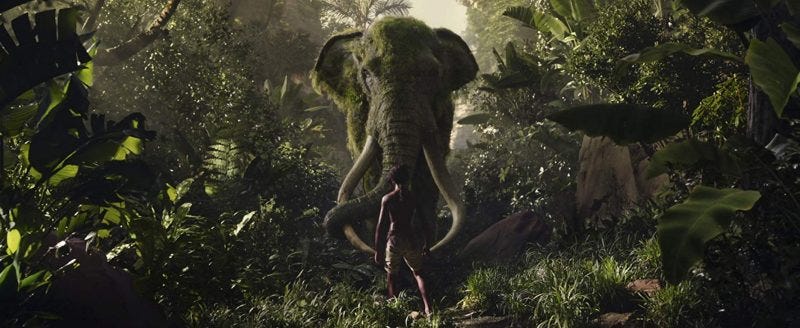Mowgli: Legend of the Jungle

It’s a very rare occasion to have two film studios announce similar projects very close to each other. In late 2013, Disney announced that Jon Favreau was attached to Disney’s latest, live-action adaptation of The Jungle Book. A few months later, Warner Bros. announced that Andy Serkis would be attached to their version of the Rudyard Kipling novel. It was at that moment that the films almost started an unofficial race between each other, making it impossible to hear updates about one version without hearing about the other. Whether it was about the cast, the tone, or the changes in the source material’s narrative, there was a point in time where anyone paying attention had a question in the back of their head: with all this accidental competition, which one would come out first?
In 2016, we found out. Disney’s “The Jungle Book” became a wildly successful film, even pulling in huge figures that no one ever expected. At that moment, the pressure was on Warner Bros. to finish the film quickly to either capitalize on the property’s rekindled popularity or focus on the aspects that make their adaptation stand out. It seems like they focused on the latter because the film finally came out at the end of 2018...as a Netflix film. While my opinions on film debuts on Netflix are a lot less harsh, it isn’t a good sign to see a major studio shift their film’s planned theatrical release to a streaming service months before its initial release date. Despite that in mind, I dove headfirst into the jungle to see if Serkis’ passion project was worth another visit to the world of Kipling.
“Mowgli: Legend of the Jungle” is a darker look into the titular man-cub. Years after Bagheera saved Mowgli from Shere Khan’s bloody rampage, Mowgli is struggling to find his place as a part of the wolfpack. Despite his training with Baloo and Bagheera, he is well aware that something makes him different than the other wolves. With the pack’s tribe trial coming up, things start to get worse for Mowgli when Shere Khan returns to cause an unrest in the jungle. With Mowgli’s life in danger, the question becomes clear: should he stay in the jungle? Or should he finally be with the man-village? These questions are commonplace in The Jungle Book. However, it’s how this film deals with those questions that gives it a bit of a fresh feel in comparison to the Disney versions.
The aspect I enjoyed the most about the film was the script. The script did a fantastic job of creating a Kipling vibe without feeling needlessly dark. Serkis discussed, prior to the film’s release, that he wanted to create a version of the classic that captured the book’s essence. While I’ve never read the novel, the film feels like how the novel was explained to me by fans: a dark, emotional edge with enough of a grounded foundation to make a talking animal novel work. It wonderfully balances the dark moments with wise ones, giving moments like Bagheera teaching Mowgli how to hunt a brutal start that end in a philosophical and contemplative way. While the script isn’t flawless, I certainly found it more interesting than both Disney versions.
Another aspect of the film that works is the performances. The film is packed with a talented ensemble that includes Christian Bale as Bagheera, Cate Blanchett as Kaa, Benedict Cumberbatch as Shere Khan, and even Andy Serkis himself as Baloo. Even Rohan Chand’s Mowgli is surprising, giving a performance that is on par (if not a bit better) than the Mowgli in the 2016 Disney film. Granted, I consider the performances from the bigger names to be good but not their most memorable. This is the type of cast where they’re so talented that they could be sleepwalking through these performances and they could still be considered better than most other’s best performances. They work well in this film, taking the script and giving it the life it needs.
That being said though, there is one aspect where the 2016 Disney film towers over the Warner Bros. version: the CGI. “Mowgli: Legend of the Jungle” has a legitimate issue with its visual effects, going through a rollercoaster of quality that equally impresses as it appalls. There are moments where you look at certain shots (such as a close-up of Bagheera’s/Baloo’s face) and think to yourself that it’s incredibly detailed and impressive. Then there are moments where the CGI makes you cringe, making you wonder how something so unpolished and rough got greenlit for an official release. For every Bagheera face or Kaa hypnosis scene, there is a scene (like the opening of the film) where you’re not surprised that many people decided to skip the film due to the effects. While I believe the film is worth watching, those dismissive claims are understandable enough, especially after seeing the final product.
It was when the credits were rolling that I realized, despite my problems with the visual effects, that I genuinely enjoyed the movie. There’s something in its approach to the characters, narrative, and even the world itself that intrigued me enough to keep my eyes on the screen. However, while its pros kept me engaged throughout its runtime, they’re not enough to get me coming back for multiple revisits. Even though I have my problems with the 2016 Disney film, it’s a much better film overall. Regardless of how faithful Serkis was trying to make this version, it’s just not as polished as its competition. In any case, “Mowgli: Legend of the Jungle” is a flawed film that’s a bit too ambitious for its own good yet, if you’re interested, is worth a watch.



